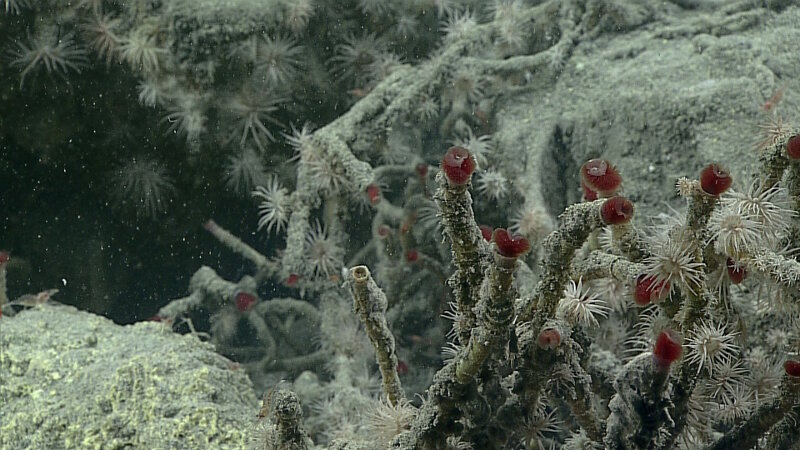
Tube worms with red gills and anemones observed at the crater rim. Image courtesy of the NOAA Office of Ocean Exploration and Research, 2016 Deepwater Exploration of the Marianas. Download larger version (jpg, 862 KB).

Tube worms with red gills and anemones observed at the crater rim. Image courtesy of the NOAA Office of Ocean Exploration and Research, 2016 Deepwater Exploration of the Marianas. Download larger version (jpg, 862 KB).
Underwater Volcano
During Dive 9, we explored the crater of Daikoku Seamount, observing active venting and thick volcanic smoke, supporting the hypothesis that there had been recent volcanic activity in the area. Plumes of likely carbon dioxide gas and sulfur were emanating from cracks and orifices near the crater rim and along the lower wall of the crater. We saw tubeworms, crabs, and a high density of flat fish specialized in living on the sulfur rich ground. Video courtesy of the NOAA Office of Ocean Exploration and Research, 2016 Deepwater Exploration of the Marianas. Download (mp4, 72.3 MB)
Dive 9 took place on Daikoku Seamount to investigate a possible 2014 eruption and assess its impacts on the local ecosystem. The seafloor and slope of the seamount were covered with volcanic ash and volcaniclastics and provided a sulfur-rich environment. Tube worms and anemones were observed, as well as a high density of flat fish specialized in living on the sulfur rich ground. Plumes of likely carbon dioxide gas and sulfur were emanating from cracks and orifices near the crater rim and along the lower wall of the crater. As remotely operated vehicle Deep Discoverer (D2) moved around the crater rim, barnacles, anemones, and tubeworms were documented. The bottom of the crater showed active venting, angular cobbles and boulders, and some irregular-shaped pieces of solid sulfur. Water column transects were conducted at the conclusion of the dive's benthic exploration. Fauna observed during these transects included larvaceans, siphonophores, amphipods, and shrimp. Throughout the dive, D2 encountered thick volcanic smoke and particulate material in the water column, supporting the hypothesis of recent activity in this area.